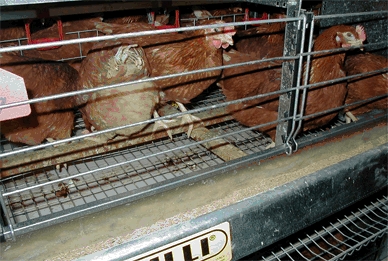Conclusions
Conclusions
Hens are prepared to work to gain access to perches at night, but there has been insufficient research work to know the extent to which perching is a behavioural priority
- Hens have a preference for a discrete, enclosed nest site and they value it sufficiently to work hard to gain access to one
- Scientists have not definitively discovered the extent to which hens value dustbathing, but there is strong evidence that it is a behavioural need
- The presence of apparently purposeless behaviour or of high levels of aggression or redirected behaviours such as feather pecking and cannibalism are important indicators that can be use to evaluate a certain housing system with respect to bird welfare
- The value of a particular substrate varies with the behaviour performed in the substrate and that there is a strong demand for peat moss for dustbathing
- Criteria to assess substrate quality in different laying hen housing systems should include recording of dustbathing behaviour activity and quality, foraging behaviour, substrate quality and housing system characteristics
- Substrate in barn systems gives more opportunities for laying hens to perform dustbathing and foraging behaviour as compared to the substrate area in furnished cage systems.
- The low proportion of hens performing foraging behaviour and the absence of complete dustbaths in furnished cage systems indicates that the substrate areas in these systems do not fulfil the needs of the hens, confirming the results of earlier studies in furnished cage systems.
- Hens in larger group cages (60 birds per cage) were found to perform more (incomplete) dustbathing than hens in 40 bird group cages
- Feather pecking is still a very predominant welfare problem in commercial flocks in non cage systems with a prevalence of between 40 and 80%. The prevalence of cannibalism is lower but with up to 20% of flocks were affected in one survey and up to 40% in another
- Hens kept in any of the four furnished cage models compared did not differ in level of feather pecking or aggressive pecking.
- The perching area of furnished cages was used typically of about 40 to 50% of the hens during the day and of 80 to 90% during the night.
- The use of perches at night was higher in the smaller compared to medium or larger furnished cages.
- The use of the dustbathing area was very different for the four models of furnished cages that could be compared from the LayWel data.
- Birds reared on floor had a slightly higher dustbating activity than cage reared birds.
- White Leghorns laid more eggs in nests in FCM compared to FCL, FCS and MT with ST in between.
- Medium Heavy hens laid more eggs in nests in non cage systems compared to furnished cages.
- White Leghorns used the nests in FCM and FCS better than Medium Heavy hens, while no difference between hen types was found in non cage systems.

| Description | download |
| 4.7 Final chapter on behaviour |